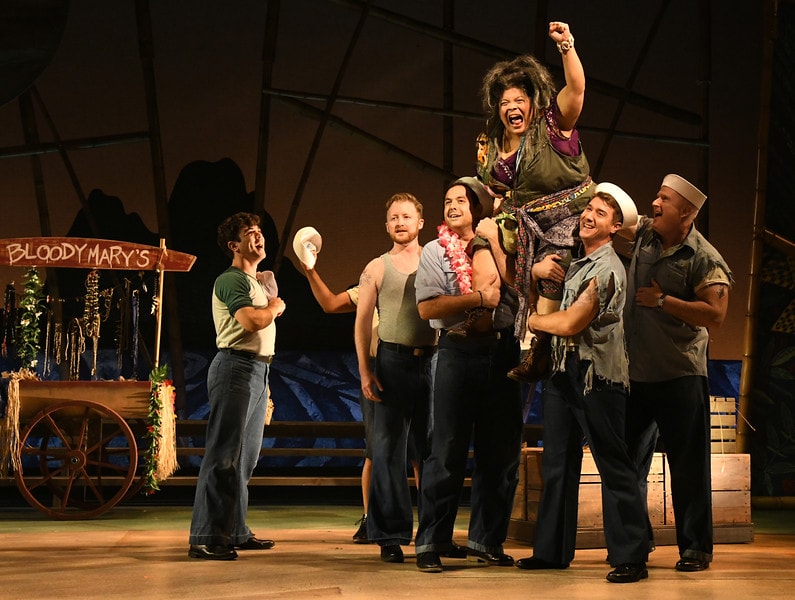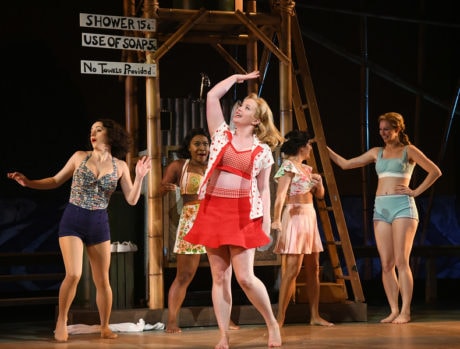No one is from there. Espiritu Santo, the main island setting of Rodgers and Hammerstein’s musical drama and the James Michener novel (Tales of the South Pacific) that inspired it, is not the dreamy Polynesian paradise of Gauguin. In 1942, the island is a hub of air and logistical support for the crucial battle of Guadalcanal, 600 miles to the northwest. For Americans and expats, the island is a temporary place, for some a place of exile. How each character tries to make a kind of home is the driving force of South Pacific, now playing in a strong production at the Olney Theatre Center.

Having left France one step ahead of the police, built a prosperous plantation (likely using the labor of native or imported non-white workers), and fathered two kids with a now-deceased Polynesian woman, Emile (William Michals) is filled with longing and anger. Michals captures the charisma, gravitas, and the force-of-nature passion of the man. Michals has the perfect strong, supple bass-baritone voice for the role, with which he draws the audience into the power of his love (“Some Enchanted Evening”), frustration and sadness (“This Nearly Was Mine,” one of the greatest R&H songs, never performed better), and bitterness (“I Was Cheated Before”).
Nellie, the 22-year old ingénue, longs for new experiences beyond her small town Arkansas upbringing. Jessica Lauren Ball gets not only the character’s naivety but her Southern girl essence. Nellie’s signature songs, which Ball performs with flair and delightful energy, are more the stuff of light musical comedy than passionate drama. Albeit written with great skill, “Wash that Man” and “Wonderful Guy” are basically rom-com numbers, and “Honey Bun” is of the “let’s put on a show” type reminiscent of a Judy/Mickey movie.
Nellie’s dramatic heft comes not from her music but from her dialogue. When Nellie flees from Emile upon learning that he lived and had children with a “colored” woman, Ball lets us see Nellie’s shock that she is prejudiced in ways that she had not previously been forced to confront. Ball makes her second act transformation believable as events inspire her to surmount her prejudice.
Bloody Mary is the most intelligent, most ruthless character in the play, a survivor, a Vietnamese cousin to Mother Courage. She is not someone to trifle with. Michener was quoted as saying “I would often think of her … when American troops were fighting their fruitless battles in Vietnam, and I wondered if our leaders realized that the enemy they were fighting consisted of millions of determined people like Bloody Mary.” Cheryl J. Campo nails Mary’s intuitive manipulativeness, as, for example, she plays on Cable’s emotions in her well-sung “Bali Ha’i”
Alex Prakken’s Cable is as young, callow, and naïve as Nellie, a choice that works wonders for a character who can easily be uninteresting. With a forceful high tenor voice, he conveys the sexual passion he feels for Bloody Mary’s daughter Liat in “Younger than Springtime.” He makes a thoughtful, effective choice as he begins “Carefully Taught,” visibly starting to figure out, for the first time, the prejudice he wasn’t fully aware of harboring and where it came from. This is a song the message of which endures, as demonstrated recently by its citation in Hamilton.

Among the supporting characters, David Schlumpf’s Billis is an overly fast-talking “operator” who is always looking for an angle, though he has a sweet moment of tenderness toward Nellie during the Thanksgiving show sequence. He gets a nice comic moment as a coconut bra-wearing diva in “Honey Bun.” As Capt. Bracket, the island C.O., Stephen F. Schmidt is consistently bombastic; a dash of MASH’s Col. Potter could have added variety to the character.
The island hospital is apparently understaffed, equipped with only four ensemble nurses rather than the original eight. While the four are full of energy and dance well, the stage seems underpopulated during “Wash that Man” and “Wonderful Guy.” There is a fuller complement of sailors for the “Bloody Mary” and “Nothing Like a Dame” scene. The men sing well, though Darren Lee’s choreography for them, active at some points, feels pedestrian at others. There is a missed opportunity, for example, to have the men jitterbug with each other during the “Bloody Mary” dance break. Playing the final “Honey Bun” reprise as a military march is an effective touch.
Costume designer Ivania Stack’s most enjoyable moment arrives with the colorful, wild and crazy collection for the Thanksgiving show. Nellie and the nurses are often in relatively modest two-piece outfits, suggestive of but likely not literally reproducing those of the 40s. One costume that misses the mark is Liat’s dress. While pretty, the dress is neither an ao dai nor the simple white top/black pants combination that Michener describes. The effect is more Suzie Wong goes Hawaiian than Vietnamese. Max Doolittle’s lighting design does its job without calling attention to itself, though the rays emanating from behind the island silhouette during “Bali Ha’i” looked a bit occult.
Attention to detail is the mark of a top-drawer production, and this production’s props design (uncredited) provides two nice examples. When a sailor accuses Billis of having two heads, Billis is wearing one of Mary’s shrunken heads around his neck, letting the line make much more sense than usual. In the interval between “Wash that Man” and “Wonderful Guy,” Emile typically leaves a broad-brimmed hat on stage, with which Nellie than dances. Instead of the hat, he leaves a bunch of red flowers, allowing an unbroken series of gifts of these red flowers from the beginning of the show through to the end.
The structure of this 1949 R&H hit is very much a creature of its era, alternating musical scenes with book scenes and filled with multiple reprises of key songs. Director Alan Muraoka follows its staging traditions faithfully. The original front-of-curtain scenes are staged in front of scenic designer Paige Hathaway’s striking tapa cloth-inspired drop (filled with evocative images of islands, airplanes, ships, and bombs). During the Thanksgiving scene, the actors spin a hand-operated platform for the backstage scenes.
Let other productions go for startling innovation; Muraoka trusts the material here and delivers a fine rendition of the South Pacific’s many virtues. Michals’ singing alone is worth the price of admission.
Running Time: 2 hours and 50 minutes, including one intermission.
South Pacific is playing through October 7, 2018, at the Olney Theatre Center – 2001 Olney-Sandy Spring Road, in Olney MD. For tickets, call the box office at 301-924-3400, or go online.




